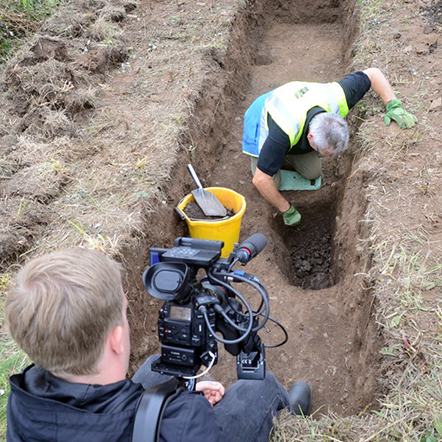The fieldwork section of the Royal Anne Project Group (MAST, Bournemouth University and the National Trust) have recently completed archaeological investigations in Pistil Meadow
Many will be familiar with the legend of the burial of 200 mariners in mass graves in Pistil Meadow following the sinking of the Royal Anne Galley in 1721, with the loss of all the crew and passengers bar three – two sailors and a boy. Two seasons of geophysical work revealed several likely anomalies which were then investigated with a limited archaeological dig in September 2016. However, the mystery of what happened that stormy November night almost 300 years ago remains unresolved.
The five evaluation trenches revealed buried features, but none of these were associated with any grave structures or led to the discovery of any human remains. While this does not exclude the possibility of small or individual graves being missed, it is felt that burials of the scale described in the various accounts written over 120 years after the event would most likely have been discovered during this work. In 1848 CA Johns reported the tale that there were 200 bodies buried in pits each containing between ten and thirty bodies. The story was subsequently retold by such well known authors as Wilkie Collins in 1850, who incorrectly suggested the Pistil meadow was so named because of the quantity of firearms, especially pistols, found in the meadow. By 1881 it was claimed by Mrs Craik there were over 200 bodies of “foreign sailors” from a complement of 700, who were found with pistols in their hands. In 1948 JC Trewin, who grew up on the Lizard, changed the numbers in the burial pits to between twenty and thirty and added that the meadow has a queerness, pungent with the scent of seaweed and camomile. Daphne du Maurier in 1967 romanticised the event further by suggesting the burials may be associated with a small grove of “grotesquely shaped” windswept willow trees. The first report stating that dogs scavenged the washed-up bodies on the beach perhaps mistakenly turned into the belief that dogs dug up the bodies from the graves. The area is said by some to be haunted to this day.
These tales may contain some truth in that it is likely that there are bodies from the sinking of the Royal Anne buried in the vicinity. Perhaps the tamarisk trees, presumably planted much later, on the other side of the stream hide a story, or has coastal erosion already claimed any grave site. A contemporary newspaper account of the Board of the Admiralty enquiry into the sinking, reported that people had rifled through some of the victim’s bodies on the beach immediately following the sinking and these bodies may have well been buried in the vicinity. However, it is possible that the numbers washed up near Pistil Meadow may not have numbered anything like the claimed 200 on board, when currents and tides would likely have swept many bodies out to sea or further along the coast to be washed up and buried elsewhere.
So while the case is far from closed, the reported accounts may well appear to differ from what we can tell happened after this tragic episode in British Naval history.
James Parry, National Trust Archaeologist October 2016



